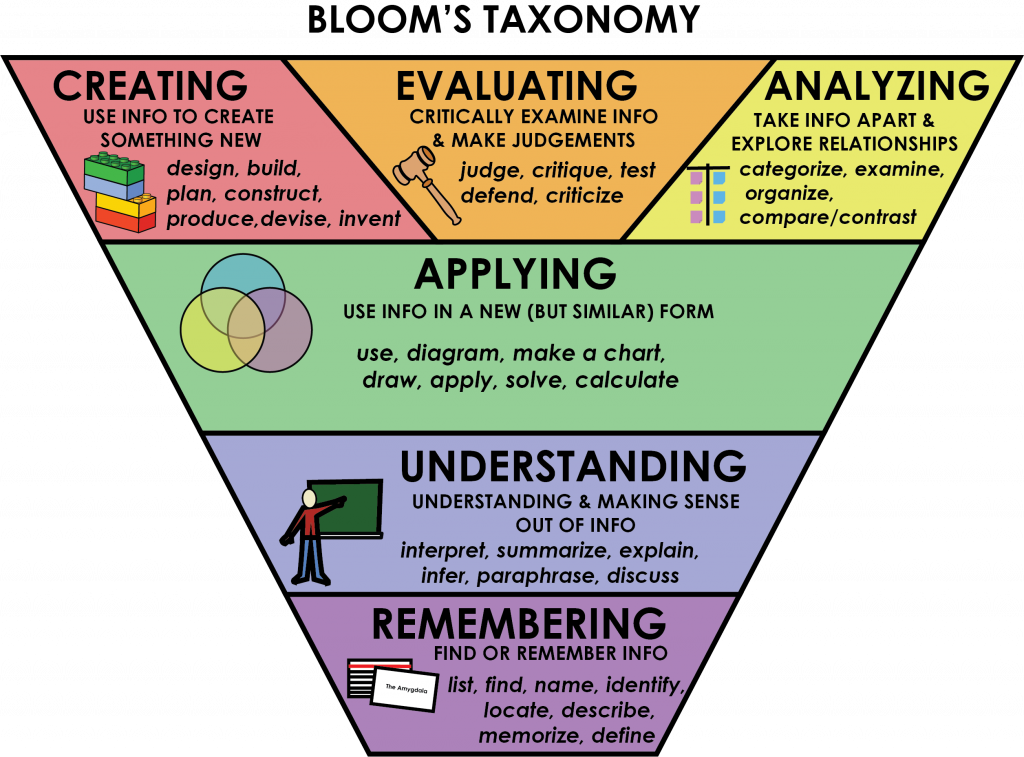18 Use Effective Questioning Strategies
Self-testing is one of the most powerful study strategies. Creating good questions requires you to think critically about what you need to learn (planning). Testing whether you can answer questions without referring to a text or notes, as you would in an exam, allows you to effectively monitor your progress. The trick to effective self-testing is asking the right questions. In university, you are required to move beyond recalling basic facts and details, and must learn to apply and analyze material deeply.
One way of picturing these levels of depth in learning is Bloom’s Taxonomy. The categories in the cognitive taxonomy developed by Bloom include:
- Remember (knowledge recall) – retrieving relevant knowledge from long-term memory
- Understand (comprehension) – interpreting the meaning of information; being able to “translate” knowledge into one’s own words; linking new information to what you already know
- Apply – using what you know to do required tasks
- Analyze – taking things apart; dissecting; asking “why?”; seeing relationships and how things work
- Evaluate – appraising, judging and critiquing the outcomes of any of the other levels
- Create (synthesis) – putting things together; building on what you know to create something new; seeing new relationships or making new connections. [1] [2]

One method for creating study questions or planning active learning activities is to move step-by-step through each level of Bloom’s Taxonomy. Begin with a few questions at the Remembering level. If you don’t yet know the technical language of the subject and what it means, it will be difficult for you to apply, evaluate, analyze, or be creative. Then, go deeper into your subject as you move through the levels.
Try It!
Create Study Questions Using Bloom’s Cognitive Taxonomy
Pick a subject area in which you are working. For each level of Bloom’s Taxonomy on this page:
- Develop a question and answer it to show that you can think about the material at that level.
- Then, working with a partner and using the chart below, explain the questions at each level of Bloom’s taxonomy for this subject area to a partner and listen to them do the same.
- Discuss how your questions would allow you to assess how much you know and what level you are working at.
| Level | Question |
| Remembering | Remembering and Recalling information.
My question(s): |
| Understanding | Understanding Explaining ideas or concepts.
My question(s): |
| Applying | Applying information in a familiar situationMy question(s): |
| Analyzing | Analyzing by breaking information into parts to explore relationships.
My question(s): |
| Evaluating | Justifying a decision or course of action.
My question(s): |
| Creating | Generating new ideas, products, or ways of viewing things.
My question(s): |
- Anderson, L. W., & Krathwohl, D. (Eds.). (2001). A taxonomy for learning, teaching, and assessing: A revision of Bloom's taxonomy of educational objectives. New York: Longman. ↵
- Bloom, B., Englehart, M. Furst, E., Hill, W., & Krathwohl, D. (1956). Taxonomy of educational objectives: The classification of educational goals. Handbook I: Cognitive domain. New York, Toronto: Longmans, Green. ↵

